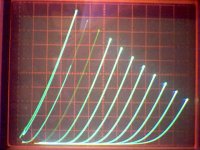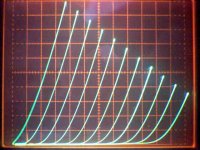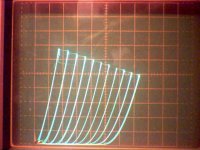Been there, done that, didn't help, sorry I asked.
http://www.mif.pg.gda.pl/homepages/frank/sheets/138/5/5654.pdf
Sounds to me that there are procedural and sampling errors in the clinic patient temperature reporting protocol, dead people are not patients they are mistakes.
Yes. And there are very similar procedural and sampling errors in THD usage to compare amplifiers of not the same architecture.
Funny, I can low-pass filter a signal to achieve any abritrary degree of "smoothness".
Tim
You are talking about waveforms i.e. signals. I was talking about transfer functions i.e. amplifiers.
Found another super-triode!
This one is easier to use than the battery op one. 6.3 V indirectly heated, octal, and has a datasheet with curves:
http://scottbecker.net/tube/sheets/127/6/6C8G.pdf
Notice the near constant Mu on page 2.
a) 6C8G 1 ma/div, 50v/div, 1.5 V/step
b) 1E7G (for comparison) 2 ma/div, 20V/div, 2 V/step
This one is easier to use than the battery op one. 6.3 V indirectly heated, octal, and has a datasheet with curves:
http://scottbecker.net/tube/sheets/127/6/6C8G.pdf
Notice the near constant Mu on page 2.
a) 6C8G 1 ma/div, 50v/div, 1.5 V/step
b) 1E7G (for comparison) 2 ma/div, 20V/div, 2 V/step
Attachments
Member
Joined 2009
Paid Member
"Did you try well known hidden in plain sight 6N6P?"
I don't have one to try, but the data sheet looks pretty good. A Mu curve would clinch the deal. Certainly a more practical tube than the battery type tubes.
http://scottbecker.net/tube/sheets/113/6/6N6P.pdf
And the GU-50, which you mentioned earlier, looks pretty good in triode: (attached 10 mA/div, 50V/div, 5.5 V/step))
I don't have one to try, but the data sheet looks pretty good. A Mu curve would clinch the deal. Certainly a more practical tube than the battery type tubes.
http://scottbecker.net/tube/sheets/113/6/6N6P.pdf
And the GU-50, which you mentioned earlier, looks pretty good in triode: (attached 10 mA/div, 50V/div, 5.5 V/step))
Attachments
Last edited:
"Did you try well known hidden in plain sight 6N6P?"
I don't have one to try, but the data sheet looks pretty good. A Mu curve would clinch the deal. Certainly a more practical tube than the battery type tubes.
http://scottbecker.net/tube/sheets/113/6/6N6P.pdf
And the GU-50, which you mentioned earlier, looks pretty good in triode: (attached 10 mA/div, 50V/div, 5.5 V/step))
Both GU-50 and 6N6P are even better in P-P mode, so I used them in Pyramid-5 amp in a LTP driver (6N6P) and output stage (GU-50).
A first gain stage and Concertina splitter was made on 6F12P that is really nice in SE.
Yes. And there are very similar procedural and sampling errors in THD usage to compare amplifiers of not the same architecture.
I get it, that is why I was speaking of procedures, sampling and reporting. Dissections and autopsies of mistakes can be revealing as well. What I want to know is what killed the patients? Could be something different than THD, could it be DSP, Digital Signal Processing? Several years ago I put the sound track for Pirates of the Caribbean on the oscilloscope. I was amazed, it was totally squeezed through the spin cycle. Tubes or solid state cannot fix that. Linearity is not on the same page with DSP compression. A bit OT back to sweet tubes.
DT
All just for fun!
I have just read through this thread, and I would like to try a GU-50 SE amp.
Having tried 832a (P-P), 829b (PSE) and GM-70 (SE) GU-50 seems a good place to go next.
However I am not a "designer" so I am looking to see who has actually built a GU-50 (triode mode) single ended amp and use an existing design as my basis.
Not worried about the PSU as I have an existing PSU that should do, it already powers two other SET amps (300b and PT15) but not at the same time.
Having tried 832a (P-P), 829b (PSE) and GM-70 (SE) GU-50 seems a good place to go next.
However I am not a "designer" so I am looking to see who has actually built a GU-50 (triode mode) single ended amp and use an existing design as my basis.
Not worried about the PSU as I have an existing PSU that should do, it already powers two other SET amps (300b and PT15) but not at the same time.
The GEC tube is probably a Z729. Whie it behaves very much like an EF86, it isn't, and sometimes it shows. Ususally, it is less noisy and hummy.WINNER! You're good at this...
Yes it is a triode-strapped EF86 (a GEC to be exact) with 3.4V on the heater (yes!)
I got quite excited when I first saw this, but unfortunately none of my other EF86s (all Mullard) demonstrate this effect, at least, not nearly so well. Still, I thought it was an interesting curiosity.
I get it, that is why I was speaking of procedures, sampling and reporting. Dissections and autopsies of mistakes can be revealing as well. What I want to know is what killed the patients? Could be something different than THD, could it be DSP, Digital Signal Processing? Several years ago I put the sound track for Pirates of the Caribbean on the oscilloscope. I was amazed, it was totally squeezed through the spin cycle. Tubes or solid state cannot fix that. Linearity is not on the same page with DSP compression. A bit OT back to sweet tubes.
One of killers is non-linear phase shift. Second killer is more distorted faster signals. Third killer is nastier perceivable distortions of fine details than loud sinusoidal tones. Fourth killer is sharpness of transfer curve as the result of attempt to make it straighter, instead of making it smoother.
But, as the result of killing of some patients the averaged measured temperature in the clinic shows as if all patients were miraculously cured.
Member
Joined 2009
Paid Member
killer is sharpness of transfer curve as the result of attempt to make it straighter, instead of making it smoother.
This matches my current philosophy.
Seems to me that this favours class A (avoiding global feedback) with tubes (maximizing linearity without global feedback)
Sometimes the patients leave by way of the front door sometimes by the backdoor. Other times the telemetry just hangs on the wall and reads 25 degrees C. Often the treatment is worse than the disease.One of killers is non-linear phase shift. Second killer is more distorted faster signals. Third killer is nastier perceivable distortions of fine details than loud sinusoidal tones. Fourth killer is sharpness of transfer curve as the result of attempt to make it straighter, instead of making it smoother.
But, as the result of killing of some patients the averaged measured temperature in the clinic shows as if all patients were miraculously cured.
Let’s consider the triode strapped pentode that has the typical triode curve. Some may want to treat it with various forms purified feedback and the shape of the curve will change. Perhaps a touch of cathode or UL feedback. A more aggressive treatment is AB Push Pull. The curve has a knee a center portion of steep double transductance and then slopes off at the shoulder. The center of the curve has a crossover notch. This curve is neither straight nor smooth; it is more efficient than Class A. Still speaking of PP, Class AB2 if you restrict your view of the curve to the center one watt of the sigmoid curve it is difficult to get any straighter or smoother. However the center watt of a 300B SET is smoother and straighter and the curves further out are sweeter.
Another treatment that will straighten and smooth is CCS, Constant Current Source (Constant Current Sink).
Some of us like a smooth curve and to play doctor.
Hello All,Sooo, you want a "smoother" transfer curve? Like, say, a cubic spline interpolation, rather than two square caps and a diagonal?
That would sound *AWFUL*. Ever play with crossover distortion before!?
Tim
Today I am playing with analog tubes not sigma delta digital analog conversion. Cubic spline interpolation is exactly what is going on inside the DAC’s connecting the digital dots or painting by the numbers smoothing the diagonals between the data points. It is wonderful what they can do, the proof is reported in the extremely small distortion numbers.
Isn’t Digital Signal Processing sucking the life out of the music what I was complaining about a few posts ago?
Tim,
No I have not played with crossover distortion. What is your experience?
DT
All Just for fun!
- Status
- This old topic is closed. If you want to reopen this topic, contact a moderator using the "Report Post" button.
- Home
- Amplifiers
- Tubes / Valves
- Could this be a perfectly linear triode?


